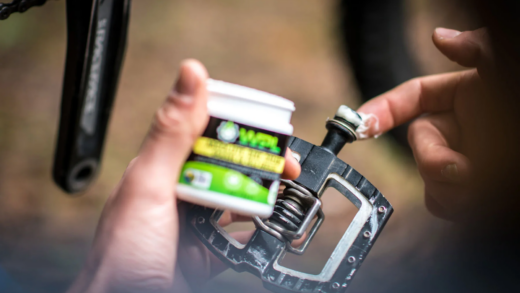When your bicycle’s forks encounter collisions, they undergo vertical movement, shifting both upward and downward. Subsequently, the oil enclosed within the fork reacts by redistributing itself, thereby delivering the necessary damping effect and maintaining a steady performance.
This equilibrium is a direct result of the inherent viscosity present within the fork oil. Various alternative fluids also possess the potential to yield equivalent viscosity levels.
Hence, the inquiry arises: what substitutions can be considered for mountain bike fork oil, including the 5wt, 10wt, and their assorted variations?
To address this concern, one viable replacement for fork oil is Automatic Transmission Fluid (ATF). Within the spectrum of viscosity aligned with fork oil, ATF would correspond to a rating of approximately 7.5 wt. Another plausible option encompasses the utilization of hydraulic oil. In the context of 5wt, hydraulic oil options like ISO 15 or 22 emerge as suitable alternatives. Likewise, for the 10wt range, a more fitting match would be ISO 32 hydraulic oil.
If the exploration of these alternatives piques your interest, I encourage you to read on until the final segment of our discourse.
Let the journey commence!
Exploring Substitutes for Fork Oil in Suspension Systems
Delving into the nuances between forks with varying travel lengths, such as comparing 100mm versus 120mm travel forks, can prove to be a perplexing task. Equally intricate is the quest for a replacement for fork oil that suits your mountain bike’s needs.
Deciphering the intricacies of fork oil’s weight measurement presents a substantial challenge. Complicating matters further is the divergence in weight measurements among different brands of fork oil.
To identify a suitable alternative to traditional fork oil, a deeper understanding of your bike becomes imperative. Factors such as your bike’s specific model and the desired level of consistency in its suspension mechanisms play pivotal roles in this determination.
Considering the multitude of factors at play, the endeavor of procuring the appropriate fork oil can metamorphose into a daunting ordeal. It’s in moments like these that the need for a viable substitute becomes pronounced. Imagine a scenario wherein the unavailability of fork oil plagues the market.
Yet, your need for it, or at the very least, a commendable alternative, remains pressing. Although our assistance may fall short in helping you procure authentic fork oil, we are well-equipped to aid you in formulating an innovative solution.
Fluid Dynamics: Unveiling the Marvels of Automatic Transmission Fluid
Unveiling an ingenious revelation in the realm of lubricants, we come across the remarkable substitute known as automatic transmission fluid (ATF). This innovation stands as a prime contender for the coveted position that fork oil traditionally occupies. The community of users who have embraced ATF right from the outset instead of the conventional fork oil has been burgeoning, attesting to its efficacy.
Tracing back in time, prior to the advent of fork oil, the stage was graced solely by the presence of ATF. Thus, its historical lineage is intricately woven into the narrative of fork oil usage. With remarkable attributes that include a notable resistance to shear forces and the ability to suppress the formation of foam, ATF confidently steps into the limelight as a formidable competitor in the lubrication landscape.
Elevating the factor of safety, ATF emerges as a superior option when juxtaposed with its potential alternatives. The equivalence in weight between alternative transmission fluid and 10 wt fork oil draws attention, presenting a compelling proposition. Delving deeper, a comparison in weight between fork oil and ATF brings to light a numerical ratio of 7.5wt, establishing ATF as an enticing candidate for those seeking alternatives in the 5 wt or 10 wt range of fork oil.
Intriguingly, some enthusiasts have ventured into an innovative concoction, melding engine oil with ATF to craft a personalized amalgam that serves as a befitting surrogate for fork oil. However, it’s vital to exercise discernment in the realm of ATF selection. An astute observation reveals that certain variants of ATF fail to exhibit optimal compatibility with fork mechanisms, underscoring the significance of selecting the right brand to achieve harmonious functioning.
Yet, even in its prowess, ATF is not without its imperfections. A careful examination uncovers that ATF is meticulously engineered to cater to the demands of torque converters. The principal duty it undertakes revolves around delivering essential lubrication to critical torque converter components, including the turbine, stator, and clutch assembly, to name a few illustrious contenders. This tailored functionality situates ATF predominantly within the realm of four-wheeled vehicles, rendering it a more apt companion for these road companions as opposed to its two-wheeled counterparts. Nonetheless, despite this nuance, ATF remains an unparalleled alternative to traditional fork oil.
Exploring Hydraulic Oil as an Alternative Option for Fork Oil
When it comes to seeking alternatives for fork oil, hydraulic oil emerges as a viable and frequently employed substitute. In essence, fork oil essentially amounts to hydraulic oil, thereby establishing a fundamental level of compatibility and safety between the two. However, beneath this apparent similarity, distinctions do exist, warranting a closer examination of their respective properties and applications.
Distinguishing Characteristics and Additive Variations:
Foam Prevention and Suspension Damping:
- Fork oil is enriched with specialized additives that actively deter the formation of foam within the oil;
- This attribute is particularly significant as it contributes to maintaining more effective suspension damping compared to hydraulic oil.
Enhanced Additives for Seal Protection:
- Hydraulic oil incorporates supplementary additives not typically present in traditional fork oil;
- Notably, these additional additives are formulated to provide enhanced protection to seals, thus contributing to prolonged equipment lifespan.
Antioxidant Properties:
- An inherent feature of hydraulic oil is its inclusion of antioxidants, which serve to mitigate the impact of oxidative processes over time.
Temperature Tolerance and Viscosity Considerations:
Resilience to High Temperatures:
- One of the strengths of hydraulic oil lies in its commendable tolerance for elevated temperatures;
- This thermal resistance is a desirable trait, ensuring stable performance even in demanding operating conditions.
Essential Role of Correct Weight and Viscosity:
- A paramount prerequisite when opting for hydraulic oil as an alternative is to select the appropriate weight, especially considering viscosity;
- The chosen viscosity directly influences the fluid’s flow characteristics and performance, thus affecting the overall functionality of the equipment.
Viscosity Specifications and Variability:
- Hydraulic oil generally adheres to a 100 ISO viscosity grade (equivalent to SAE 30);
- It is worth noting that similar to motor oils, the viscosity grades of hydraulic oil may vary based on application requirements.
Selecting the Optimal Hydraulic Oil Viscosity:
Comparative Guidelines for Fork Oil Substitution:
- To determine the suitable hydraulic oil viscosity in comparison to fork oil, a reference point is invaluable;
- For instance, a 5 wt fork oil corresponds to an ISO 15 hydraulic oil viscosity.
Matching for Different Fork Oil Grades:
If your intention is to replace 10wt fork oil, an ISO 32 hydraulic oil offers a fitting match.
Likewise, ISO 22 hydraulic oil effectively aligns with the requirements of 10wt fork oil.
Precision in Fork Oil Replacement:
When the goal is to transition from fork oil to hydraulic oil, these recommended ISO viscosities provide a close match, ensuring consistent performance and functionality.
Exploring Alternatives
Upon contemplating alternatives to fork oil, two prominent options that shine are Automatic Transmission Fluid (ATF) and Hydraulic oil. However, in the event that procuring these lubricants poses a challenge, a handful of supplementary selections do exist. It’s imperative to note, though, that these alternatives should be approached with caution, preferably sidestepped whenever feasible.

Venturing into the realm of unconventional alternatives might seem amusing, yet the application of peanut butter or jelly holds potential. Their inherently thicker consistencies, compared to the customary lubricating oils, render them worthy contenders in this unique realm of substitution.
Given the paramount importance of a substitute’s viscosity when replacing fork oil, a pivotal parameter must be upheld—its consistency should not veer toward the lower end of the spectrum. Consequently, the utilization of commonplace lubricating oils is to be eschewed, as they typically do not meet this viscosity criterion.
Among the gamut of suggestions, a proposition emerges that proposes the use of motor oil or engine oil as stand-ins for fork oil. However, an essential caveat accompanies this proposition: only if the exact weight equivalency is meticulously determined should this avenue be explored. The intrinsic variance in weight measurements between engine oil and fork oil necessitates precision in this regard.
To elaborate, consider that a specific weight of engine oil, say 5wt, holds parity with a significantly higher weight of fork oil, around 40wt. This substantial disparity underscores the importance of identifying the congruent weight to ensure a successful substitution. Lest this weight alignment be ascertained, entrusting the wellbeing of your motorcycle to motor or engine oil is an unadvisable undertaking.
A prudent course of action is to engage in a preliminary consultation with a seasoned professional prior to making any definitive choices. The potential ramifications of an ill-suited choice extend not only to the mechanical state of your bike but also to the proficiency of your riding skills.
Navigating Motorcycle Suspension: The Unraveled Essence of Fork Oil
Within the realm of your motorcycle’s mechanics, fork oil emerges as a truly indispensable agent. Its pivotal role revolves around the establishment of uniformity – ensuring unwavering rebounds and consistent dampening, adeptly adapting to the ever-shifting thermals.
This substance stands as the quintessential constituent your motorcycle’s suspension hungers for, its irreplaceable nature incontrovertible. Ingenious substitutes pale in comparison to the essence of fork oil itself, for it stands peerless.
Though it may bear a somewhat weighty price tag, fidelity to the tried and true option remains sage, barring any undue leakage of this precious elixir from your fork.
The allure of altering brands should be met with caution as different brands adhere to their unique viscosity standards for fork oil. Thus, the 5wt fork oil coursing through your system may not harmonize with its counterpart from a divergent label.
Having personally subjected myself to the experiment of testing myriad fork oils from various manufacturers, the inexorable conclusion remains: I unfailingly revert to the embrace of Maxima fork oils. Their unparalleled ease of application and exemplary performance hold me captive.
Hence, exercise restraint in seeking alternatives unless absolutely compelled. Yet, if this crossroads is reached, contemplate the crossfire between ATF and hydraulic oil. Should uncertainty cloud your path, enlisting the counsel of those well-versed in this realm stands as a prudent maneuver.
Conclusion
The comprehensive discussion revolves around the alternative options for mountain bike fork oil, encompassing variations such as 5wt, 10wt, and the spectrum of other oil variants. This enlightens you regarding the array of choices at your disposal and the prerequisites tied to their utilization.
However, exercising an extra layer of caution before embarking on the fork oil replacement process is of paramount importance. The adoption of an inappropriate substitute has the potential to not only lead to additional expenditures but also trigger a cascade of inconveniences that might prove considerably taxing.
Wishing you secure and enjoyable rides!






